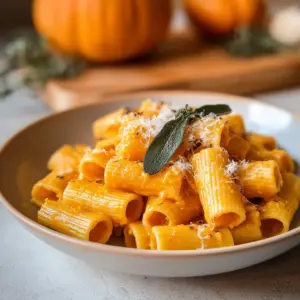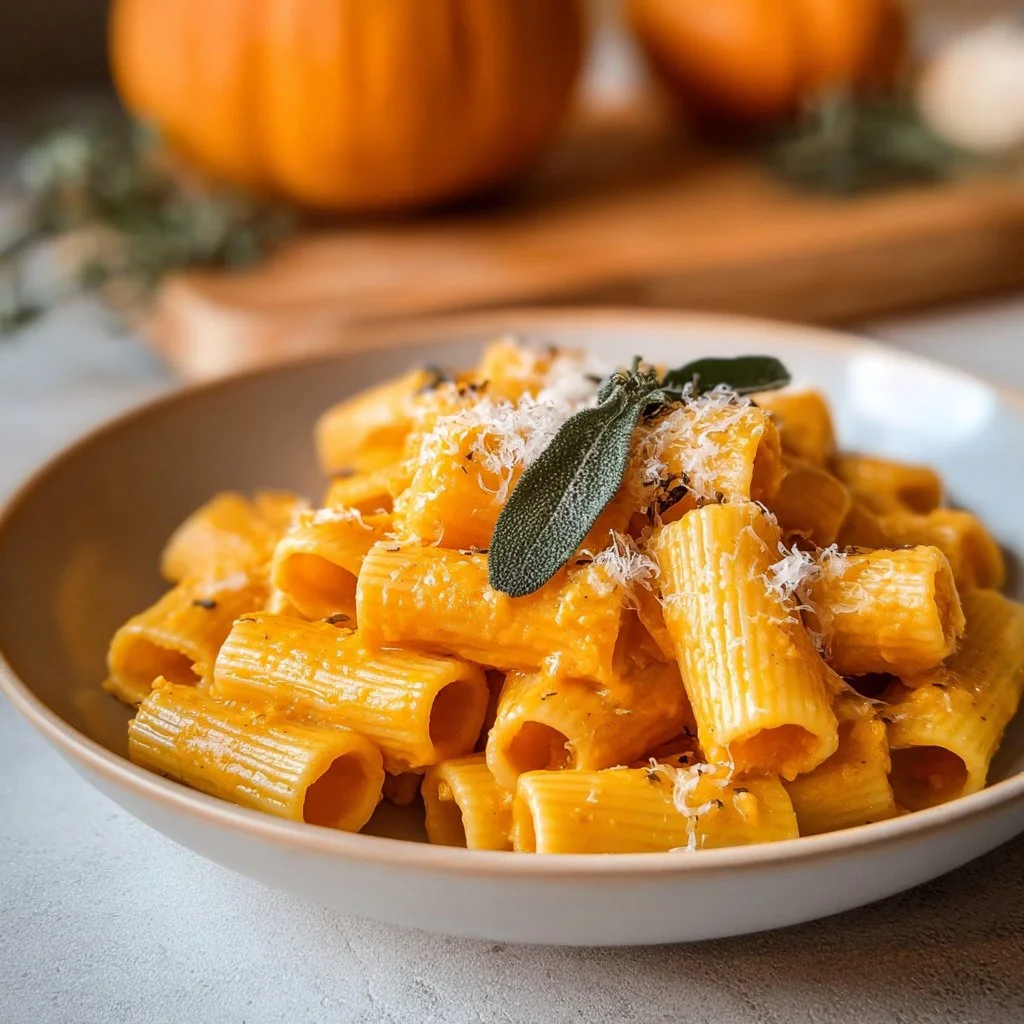Roasted Butternut Squash and Sage Pasta is more than just a meal; it’s a warm hug on a plate, offering a delightful blend of flavors and textures. Butternut squash, with its natural sweetness and creamy texture, pairs beautifully with the distinct, earthiness of fresh sage. This dish is perfect for a cozy dinner in or an impressive offering at a gathering.
Why We Love This Roasted Butternut Squash and Sage Pasta Recipe
There’s something undeniably comforting about a bowl of pasta adorned with roasted vegetables. Roasted Butternut Squash and Sage Pasta stands out in this category due to its perfect balance of flavors. The roasted butternut squash becomes caramelized as it cooks, enhancing its sweetness. When combined with the crispy sage, you get burst of flavors with every bite.
This dish is not only simple to make, but its sophisticated taste makes it appealing for both casual family meals and special occasions. The use of quality ingredients, such as fresh sage and extra virgin olive oil, ensures that the dish is not just delicious but also wholesome. Plus, it’s vegetarian-friendly, allowing everyone at the table to enjoy it.
Ingredients for Roasted Butternut Squash and Sage Pasta
To create this mouthwatering dish, gather the following ingredients:
- 1 medium butternut squash, peeled and cubed
- 2 cups fresh sage leaves
- 8 oz pasta (fettuccine or penne is recommended)
- 3 tbsp extra virgin olive oil
- 1/2 cup freshly grated Parmesan cheese
- Salt and pepper to taste
With these straightforward ingredients, you can turn simple elements into a fantastic dish that warms the heart and fills the belly.
How to Make Roasted Butternut Squash and Sage Pasta
Now that you have your ingredients ready, let’s dive into the cooking process. This is where the magic happens!
- Preheat the Oven: Start by preheating your oven to 400°F (200°C). This is the perfect temperature to achieve that golden brown finish on your squash.
- Prepare the Baking Sheet: Line a baking sheet with parchment paper to prevent the squash from sticking. This also makes for easier cleanup.
- Toss the Squash: In a bowl, toss the cubed butternut squash with olive oil, ensuring each piece is coated. Season with salt and pepper to taste. Arrange the squash in a single layer on your prepared baking sheet, ensuring there is some space between the pieces for even roasting.
- Roast the Squash: Place the baking sheet in the oven and roast the squash for 25-30 minutes. You want the squash to be tender and lightly caramelized. Halfway through roasting, give it a stir to promote even cooking.
- Cook the Pasta: While the squash is roasting, bring a pot of salted water to a boil. Add your pasta and cook according to the package instructions until it’s al dente. Be sure to stir occasionally to prevent sticking.
- Sauté the Sage: In a skillet, drizzle a little olive oil and heat it over medium heat. Add the fresh sage leaves to the skillet. Cook for about two minutes until the leaves are crispy. They will add a crunchy texture and aromatic flavor to the dish.
- Combine Everything: Once the squash is roasted and the pasta is cooked, drain the pasta and return it to the pot. Add the roasted butternut squash and sautéed sage. Toss everything together gently, ensuring the squash is evenly distributed throughout the pasta.
- Serve and Enjoy: Divide the warm pasta into serving bowls and generously top with freshly grated Parmesan cheese. You can also add a little more olive oil or seasoning if desired.
Your Roasted Butternut Squash and Sage Pasta is now ready to tantalize your taste buds!
How to Serve Roasted Butternut Squash and Sage Pasta
Serving your Roasted Butternut Squash and Sage Pasta can elevate the entire dining experience. Here are a few thoughtful tips on how to present your dish:
- Choose the Right Plate: A shallow pasta bowl or a wide, flat plate works best for showcasing the lovely colors of the dish. The gold and orange hues from the squash will pop against a white or dark plate.
- Garnishing: Enhance your dish visually with a sprinkle of additional Parmesan cheese on top. A few crispy sage leaves can also make for an attractive garnish.
- Accompaniments: Consider serving with a simple side salad or warm, crusty bread to complement the meal. A light drizzle of extra virgin olive oil over the pasta upon serving can add a lovely sheen and flavor.
- Temperature: Serve the pasta immediately while it’s warm. This dish is best enjoyed right after you combine everything, as the flavors are freshest.
Creating an inviting dining atmosphere can make your simple meal feel extra special.
Expert Tips
To ensure your Roasted Butternut Squash and Sage Pasta comes out flawlessly, keep these tips in mind:
- Choose Quality Ingredients: Fresh ingredients make all the difference. Opt for a good quality Parmesan cheese and fresh sage, as these flavors are prominent in the dish.
- Don’t Overcrowd the Baking Sheet: When roasting the squash, make sure the cubes are spread out. Overcrowding can lead to steaming rather than roasting, which affects texture.
- Taste As You Go: Before serving, taste the pasta to see if it needs additional salt or pepper. Adjusting flavors at this stage ensures a finished product that is perfectly seasoned.
- Mix Gently: When combining the pasta, roasted squash, and sage, mix gently to maintain the squash’s shape. You want to distribute everything evenly without smashing the squash.
- Use Leftover Squash: If you have leftover roasted butternut squash, this can be used in salads or blended into soups for future meals.
Implementing these tips will elevate your cooking, ensuring that your pasta dish impresses both you and your guests.
How to Store Roasted Butternut Squash and Sage Pasta
If, by any chance, you have leftovers, here’s how to properly store your Roasted Butternut Squash and Sage Pasta:
- Cool Down: Allow the pasta to cool to room temperature before storing. This helps prevent condensation that can lead to sogginess.
- Use an Airtight Container: Transfer the cooled pasta into an airtight container. This will help keep the flavors intact and prevent drying out.
- Refrigeration: Store the container in the refrigerator where it should stay fresh for up to 3 days.
- Reheating: When you’re ready to enjoy your leftovers, warm the pasta in a skillet with a splash of water or olive oil to revive the flavors. Stir occasionally until heated through.
By following these storage guidelines, you can enjoy leftovers without sacrificing taste or quality.
Variation of Roasted Butternut Squash and Sage Pasta
While the original recipe is amazing on its own, you can easily adapt or modify it to suit your taste. Here are some delightful variations you might consider:
- Add Protein: If you want to add some protein to your dish, consider including grilled chicken or chickpeas. These additions will complement the flavors and make your meal more substantial.
- Vegetable Add-ins: Feel free to incorporate other vegetables such as spinach, kale, or brussels sprouts. Just sauté these with the sage or stir them into the pasta right before serving.
- Nuts for Texture: Throw in some toasted pine nuts or walnuts for an extra crunch. This adds a lovely texture contrast against the creamy butternut squash.
- Cheese Options: While Parmesan is classic, feel free to experiment with other cheeses. A sprinkle of goat cheese or feta can provide a tangy twist to the flavor profile.
- Spices and Seasonings: Don’t shy away from adding other spices. A pinch of nutmeg can enhance the squash flavor, while a dash of crushed red pepper can add a delightful kick.
These variations open up opportunities for creativity in the kitchen, allowing you to customize the dish according to your preferences or what you have on hand.
FAQ about Roasted Butternut Squash and Sage Pasta
You might still have questions about Roasted Butternut Squash and Sage Pasta. Let’s address some frequently asked ones that can help you perfect your dish:
1. What type of pasta should I use for Roasted Butternut Squash and Sage Pasta?
For this recipe, fettuccine or penne pasta works best due to their ability to hold the flavors and ingredients effectively.
2. Can I make Roasted Butternut Squash and Sage Pasta ahead of time?
Absolutely! You can roast the squash and cook the pasta ahead of time. Just store them separately in airtight containers in the fridge and combine them before serving.
3. Is there a vegan option for this recipe?
Yes! To make this dish vegan, you can simply omit the Parmesan cheese or use a plant-based alternative. The dish remains delicious without compromising flavor.
4. How can I enhance the flavors in my Roasted Butternut Squash and Sage Pasta?
Adding garlic or a sprinkle of nutritional yeast can enhance the dish’s depth. Use your favorite spices or herbs to achieve a unique twist.
5. Can I freeze Roasted Butternut Squash and Sage Pasta?
While you can freeze the roasted butternut squash separately, pasta dishes generally retain better texture when stored in the fridge. Reheating frozen pasta may result in a soft consistency.

Roasted Butternut Squash and Sage Pasta
Equipment
- Oven
- Baking Sheet
- Skillet
- Pot
Ingredients
- 1 medium Butternut Squash Peeled and cubed
- 2 cups Fresh Sage Leaves
- 8 oz Pasta Fettuccine or penne recommended
- 3 tablespoons Extra Virgin Olive Oil
- 0.5 cup Freshly Grated Parmesan Cheese
Instructions
- Preheat your oven to 400°F (200°C).
- Line a baking sheet with parchment paper. Toss the cubed butternut squash with olive oil, salt, and pepper, then arrange in a single layer on the baking sheet.
- Roast the squash for 25-30 minutes, stirring halfway through, until tender and caramelized.
- While the squash is roasting, cook the pasta in salted water according to package instructions until al dente. Drain and set aside.
- In a skillet, heat a little olive oil over medium heat and add the fresh sage leaves. Cook for about 2 minutes until crispy.
- Once the squash is roasted and the pasta is cooked, return the pasta to the pot. Add the roasted butternut squash and sautéed sage, tossing gently to combine.
- Serve warm, topped with freshly grated Parmesan cheese and additional olive oil if desired.
Send me this recipe!
Just enter your email below and get it sent straight to your inbox!



